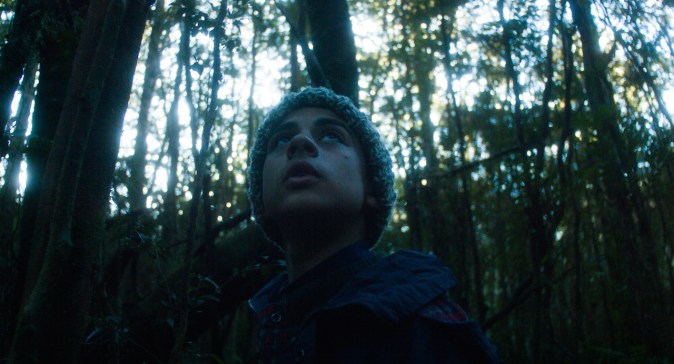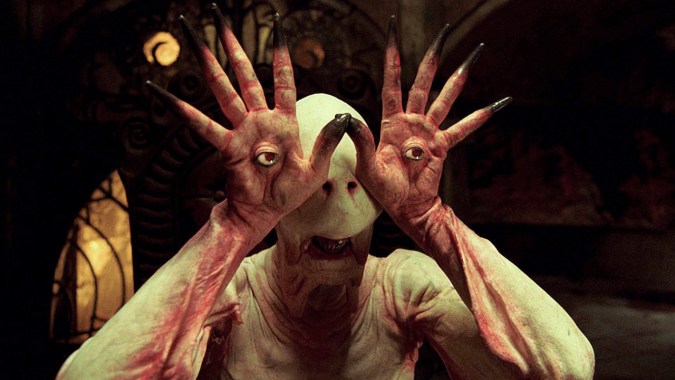Titles don’t get more blunt than Hombre. Indeed, Juan Pablo Arias Muñoz‘s short film concerns itself with the notion of what it means to be a man. A boy and his father head to the woods so that the young man can be initiated into the rituals of traditional masculinity. Over a campfire, he’s encouraged to drink from a flask. In broad daylight against a backdrop of snow-capped mountains, he’s taught how to use a gun to hunt game. The young boy’s hesitancy over these attempts to get him to “man up” leave him uncomfortable. And by the time night falls and they’re in the kind of wooded area films like The Blair Witch Project have always warned you about, this eerie treatise on modern gender norms becomes an all-out horror fest, replete with the kind of monstrous presence that’ll give you nightmares for days to come.
Shot with gritty simplicity and a knack for discomfiting sound design (really, is there anything creepier than a crack of a branch in the middle of the night?), Hombre is a modern-day fable about toxic masculinity. Its Chilean director spoke with Remezcla ahead of his short film’s North American Premiere at the New York Film Festival to talk about his influences (Del Toro, obviously), his frustration with contemporary horror films, and why Kubrick made him pursue filmmaking in the first place. Check out our chat below.

Hombre screened during Shorts Program 2: Genre Stories at the New York Film Festival.
How did you first get started in filmmaking?
I’m from Chile. I went to film school over there, in Santiago which is where I’m from. I worked over there as a director for a few years. I was directing short films and music videos. Then I came to LA—right now I’m studying at AFI in the directing program. That’s pretty much it. Since I was 12 I dreamed of becoming a director. And I’ve never stopped. It started with movies. Like, specific movies. When I became aware that I was interested then I started to really pay attention to directors and really seeing how important they were to making the stories what they are. So that’s when I started to notice certain names and started watching their movies. Like, the first time I remember actually thinking about the concept of the authors, of the director, is whenever I started watching Kubrick films. I remember I was like 15. And for me, movies before I was 15—I liked movies a lot—but I remember that was the first time I actually sat down and watched a Stanley Kubrick film on my own. Not because it was on TV or whatever. That really made me think a lot about movies can be beyond just being a lot of fun.
How did Hombre come about?
We wanted to do two different things. One, the most important one, is that we wanted to make a film that reflected about the male gender. And male gender identity. Make a comment on how these hypermasculine messages determine a boy’s self-image and how he becomes an adult, basically. And how this abusive way of teaching a kid how to be a “man” have a strong impact on the kind of man he becomes. The other thing we wanted to do was make a horror film. But where the point of the movie wasn’t survival. The point of the movie, for me, for it to be meaningful had to be more than surviving. In this case, it’s his identity that is on the line. Those are the stakes.
“I’m usually frustrated when I can’t walk away from a horror movie with something to think about.”
And they’re high stakes.
They’re high stakes but not in the way it is in regular horror films. I love that genre but I’m usually frustrated whenever I watch horror films because I think they lack the intention of actually meaning something. The horror genre is a great place for really deep ideas. Fear—actual fear—as a feeling is very pure. It’s very physical and it gets through to the audience. It’s usually just regarded usually as cheap entertainment even by the people who make horror films. For me, I’m not just interested in horror but it is one of the genres that I love. And I’m usually frustrated when I can’t walk away from a horror movie with something to think about. And really have horror be part of the story.
Do you have any examples of the type of horror movies that you think accomplish that?
For sure. I mean, most horror films that are remembered have that. When we started making this film there were a bunch of good horror films that were going around the festival circuit and being released commercially. When I was working on Hombre, I remember The Witch was out; It Follows, The Babadook. They all came out really close to one another. And that was really refreshing and reassuring of how people actually felt the same way as I did when it comes to horror, because of how they received these films.

One of the things that truly makes this feel like a horror film is its monster. Can you talk a bit about how you and your team designed its look?
“We watched a lot of how Guillermo del Toro makes his monsters in terms of technique. Because, like him, we wanted it to be all production design and makeup. We didn’t want to use CGI.”
We wanted to make a point: there’s no direct reference to the relationship with the father, but we wanted to make the monster feel like a phallic representation of manhood, in a raw way. This monster represents the kind of man that’s going to come out of him because of all this abuse. So we wanted something that felt raw and undetermined. That’s why the monster’s white. That’s why he’s naked. And you can see his full naked body at one point in the film. We wanted to have this feeling of like, a sexual threat to the boy. Speaking to the art director and to the makeup effects person that worked in the movie, we went to several reference.
In movies we concentrated on two different movies: one was Pan’s Labyrinth. That was one big reference for us. There’s a monster in that movie that looks a lot like the one we did. We watched a lot of how Guillermo del Toro makes his monsters in terms of technique. Because, like him, we wanted it to be all production design and makeup. We didn’t want to use CGI. Another cheap movie that I remember watching when I was 16 or 17 that had Amy Smart get lost in like a road trip (I don’t even remember the name of the movie [Seventh Moon]) but I remember watching it back then and she gets lost in China and it was at night. And then these half-naked men started appearing out of nowhere, started terrorizing her and her husband. For some reason that image of a naked white man in the dark kind of stuck with me for over 10 years—I have no idea why! And it came out in this movie.
It might be too early to ask this, but I’m curious about what’s next.
In Chile, with my production company, Pajareza Films, we’re working on several feature projects. In different genres. So we have a thriller, a horror film, a drama, and a documentary. We’re pushing those four projects forward. We also two short films as well. Those we applied for funding from the government of Chile this year and we’re waiting to hear about that. And we’re hoping to push our way through with one of them. Then for AFI, to graduate I’ll have to work on a short film. And I’ve also been approached by some people who are interested in making a feature out of Hombre, so I’m starting to develop a feature out of that.




